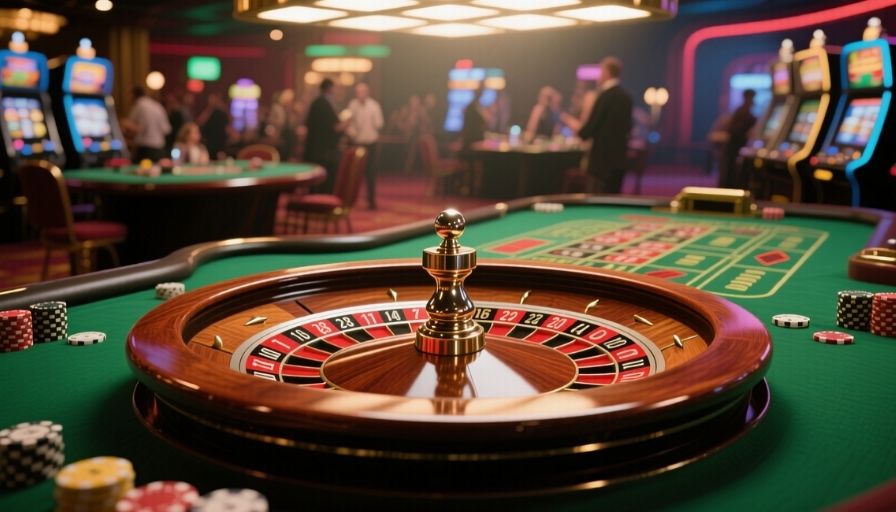A closer look at American roulette reveals more than just a simple casino game—its mechanics and mathematical structure offer practical insights into risk management and decision making.
In July 2025, industry data confirmed that the house edge on American roulette remains 5.26 per cent—almost double that of European roulette at 2.7 per cent. That single additional slot, the double zero, shifts the odds significantly against players and has become a defining feature of the American version.
This article explores the background and appeal of the game, how it works in practice, the strategies people often attempt, and the lessons that can be drawn about risk and decision-making beyond the casino floor.
The history and appeal of American roulette
Roulette’s origins can be traced to 17th-century France, where a rudimentary form of the game is said to have emerged from experiments with perpetual motion. The modern European version, which included a single zero, spread through gambling houses across the continent during the 18th and 19th centuries. When the game reached the United States, casinos introduced a second zero. This adjustment increased the advantage for the house and set the American version apart.
Despite the higher edge against the player, American roulette became firmly established in US casinos throughout the 19th century. The visual drama of the spinning wheel and the suspense of the bouncing ball made it popular among casual players as well as seasoned gamblers. The appeal lies in its combination of straightforward rules and the instant clarity of outcomes. Unlike card games that may require memorisation or strategic play, roulette’s results are immediately obvious—either the ball lands on your choice, or it does not.
Today, American roulette continues to draw attention both in physical casinos and in digital formats. Its familiarity, colourful presentation, and the balance between luck and probability contribute to its lasting place in gambling culture.
How the game works and common strategies
An American roulette wheel contains 38 numbered pockets: numbers 1 through 36, plus 0 and 00. Players can place bets on a single number, a group of numbers, or broader categories such as red or black, odd or even. The payout varies depending on the level of risk. A single number pays 35 to 1, while an even-money bet, such as red or black, pays 1 to 1.
The addition of the 00 pocket means the probability of winning an even-money bet is 18 out of 38, or around 47.4 per cent. The remaining 52.6 per cent favours the house, creating the 5.26 per cent edge. While this difference may seem small, over many spins it creates a consistent advantage for the casino.
Because of this built-in disadvantage, many players experiment with different betting strategies. Some test them first using an american roulette simulator, which allows repetition of spins without financial risk. The Martingale system, for instance, suggests doubling the bet after each loss in the hope that one eventual win will recover all losses. Another, known as the Labouchère system, involves creating a sequence of numbers that guide the amount wagered to reach a predetermined profit.
These methods demonstrate how players attempt to impose structure on a game of chance. However, none can alter the mathematical reality of the house edge. Simulations consistently show that while a strategy may delay losses or create the appearance of success in the short term, the probabilities eventually assert themselves.
Understanding risk through the roulette wheel
Roulette illustrates the concept of risk in a clear and accessible way. Each spin is independent, meaning previous outcomes do not influence future results. Yet the house edge ensures that across a large number of spins, the casino will always come out ahead.
Consider a player who brings $100 to the table and wagers in $5 increments. Even if they experience short winning streaks, the expectation is that 5.26 per cent of every dollar wagered will be lost over time. If the player places 40 bets of $5, they will have risked $200 in total. The expected loss, therefore, is a little over $10—not from the starting stake, but from the sum of all wagers placed.
This distinction highlights how small disadvantages compound. While individual spins may provide moments of excitement and occasional wins, the underlying mathematics gradually erodes the bankroll. It is a practical example of how negative expectation games function, offering a simple but powerful lesson in probability.
Lessons roulette offers for financial decision-making
The structure of American roulette reflects scenarios that extend well beyond the gaming floor. One lesson is that costs, even when small, matter significantly over time. Just as the double zero tips the odds away from the player, transaction fees, hidden charges, or interest rates in personal finance can accumulate quietly until their impact becomes unavoidable.
Another lesson involves strategies that appear to manage losses. Systems like Martingale can work in the short term but fail dramatically when a losing streak exceeds available funds. Similarly, in finance, doubling down on investments that continue to lose value may create larger setbacks rather than recovery.
Roulette also underscores the importance of compounding. In gambling, negative compounding leads to long-term losses as the house edge asserts itself. In finance, compounding can work positively when savings grow through reinvested returns, but negatively when debts accumulate interest. The ability to recognise whether compounding is working for or against you can shape long-term outcomes.
Ultimately, American roulette demonstrates that probability and discipline are central to decision-making. While it remains a form of entertainment, its mechanics can remind us of broader truths about risk, cost, and reward.
What´s Next?
American roulette is more than a pastime; it is a practical model for understanding how risk operates and how small disadvantages accumulate over time. By observing its structure, strategies, and mathematical outcomes, parallels can be drawn with personal finance and decision-making.
The wheel may be a game of chance, but the lessons it offers about probability, patience, and long-term thinking reach well beyond the casino.
